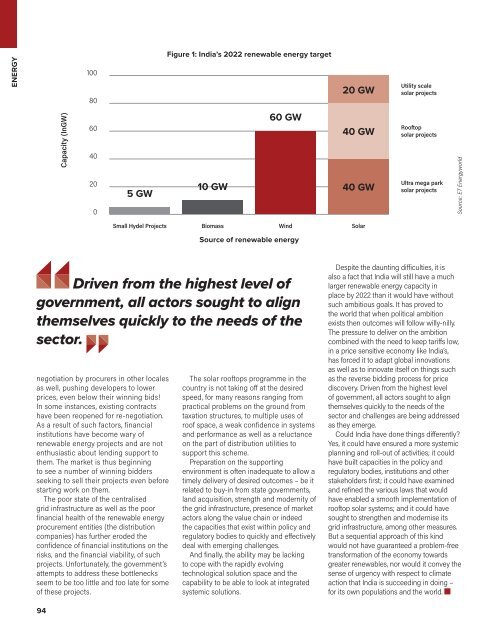Climate Action 2017-2018
Create successful ePaper yourself
Turn your PDF publications into a flip-book with our unique Google optimized e-Paper software.
ENERGY<br />
100<br />
80<br />
Figure 1: India’s 2022 renewable energy target<br />
20 GW<br />
Utility scale<br />
solar projects<br />
Capacity (InGW)<br />
60<br />
40<br />
20<br />
0<br />
5 GW<br />
10 GW<br />
60 GW<br />
40 GW<br />
40 GW<br />
Rooftop<br />
solar projects<br />
Ultra mega park<br />
solar projects<br />
Source: ET Energyworld<br />
Small Hydel Projects Biomass Wind Solar<br />
Source of renewable energy<br />
Driven from the highest level of<br />
government, all actors sought to align<br />
themselves quickly to the needs of the<br />
sector.<br />
negotiation by procurers in other locales<br />
as well, pushing developers to lower<br />
prices, even below their winning bids!<br />
In some instances, existing contracts<br />
have been reopened for re-negotiation.<br />
As a result of such factors, financial<br />
institutions have become wary of<br />
renewable energy projects and are not<br />
enthusiastic about lending support to<br />
them. The market is thus beginning<br />
to see a number of winning bidders<br />
seeking to sell their projects even before<br />
starting work on them.<br />
The poor state of the centralised<br />
grid infrastructure as well as the poor<br />
financial health of the renewable energy<br />
procurement entities (the distribution<br />
companies) has further eroded the<br />
confidence of financial institutions on the<br />
risks, and the financial viability, of such<br />
projects. Unfortunately, the government’s<br />
attempts to address these bottlenecks<br />
seem to be too little and too late for some<br />
of these projects.<br />
The solar rooftops programme in the<br />
country is not taking off at the desired<br />
speed, for many reasons ranging from<br />
practical problems on the ground from<br />
taxation structures, to multiple uses of<br />
roof space, a weak confidence in systems<br />
and performance as well as a reluctance<br />
on the part of distribution utilities to<br />
support this scheme.<br />
Preparation on the supporting<br />
environment is often inadequate to allow a<br />
timely delivery of desired outcomes – be it<br />
related to buy-in from state governments,<br />
land acquisition, strength and modernity of<br />
the grid infrastructure, presence of market<br />
actors along the value chain or indeed<br />
the capacities that exist within policy and<br />
regulatory bodies to quickly and effectively<br />
deal with emerging challenges.<br />
And finally, the ability may be lacking<br />
to cope with the rapidly evolving<br />
technological solution space and the<br />
capability to be able to look at integrated<br />
systemic solutions.<br />
Despite the daunting difficulties, it is<br />
also a fact that India will still have a much<br />
larger renewable energy capacity in<br />
place by 2022 than it would have without<br />
such ambitious goals. It has proved to<br />
the world that when political ambition<br />
exists then outcomes will follow willy-nilly.<br />
The pressure to deliver on the ambition<br />
combined with the need to keep tariffs low,<br />
in a price sensitive economy like India’s,<br />
has forced it to adapt global innovations<br />
as well as to innovate itself on things such<br />
as the reverse bidding process for price<br />
discovery. Driven from the highest level<br />
of government, all actors sought to align<br />
themselves quickly to the needs of the<br />
sector and challenges are being addressed<br />
as they emerge.<br />
Could India have done things differently?<br />
Yes, it could have ensured a more systemic<br />
planning and roll-out of activities; it could<br />
have built capacities in the policy and<br />
regulatory bodies, institutions and other<br />
stakeholders first; it could have examined<br />
and refined the various laws that would<br />
have enabled a smooth implementation of<br />
rooftop solar systems; and it could have<br />
sought to strengthen and modernise its<br />
grid infrastructure, among other measures.<br />
But a sequential approach of this kind<br />
would not have guaranteed a problem-free<br />
transformation of the economy towards<br />
greater renewables, nor would it convey the<br />
sense of urgency with respect to climate<br />
action that India is succeeding in doing –<br />
for its own populations and the world.<br />
94












